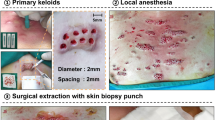Abstract
Purpose
A keloid scar often appears at the incision site of patients after median sternotomy. Use of silicone gel to treat hypertrophic burn scars and fresh incisions has yielded encouraging results. In this study, we report our experience with the preventive use of silicone gel sheets for keloid scars after median sternotomy.
Methods
Nine patients who underwent a median sternotomy were studied. A silicone gel sheet was kept directly on the surgical incision for 24 h starting 2 weeks after surgery. The treatment was repeated with a new sheet every 4 weeks for 24 weeks, at which times the subjective symptoms and the changes in keloid scars were determined.
Results
None of the patients experienced an aggravation of any subjective symptoms during the 24-week study. After 24 weeks, all patients were free of a keloid scar that showed a rise and contraction of skin and causes discomfort. No adverse events were reported by any of the patients.
Conclusion
A silicone gel sheet is safe and effective for the preventing the formation of keloid scars after median sternotomy.
Similar content being viewed by others
References
Ahn ST, Monafo WW, Mustoe TA. Topical silicone gel for the prevention and treatment of hypertrophic scars. Arch Surg 1991;126:499–504.
Quinn KJ, Evans JH, Courtney JM, Baylor JDS. Non-pressure treatment of hypertrophic scars. Burns 1985;12:102–108.
Quinn KJ. Silicone gel in scar treatment. Burns 1987;13:33–40.
Sawada Y, Sone K. Hydration and occlusion treatment for hypertrophic scars and keloids. Br J Plast Surg 1992;45:599–603.
Chang CC, Kuo YF, Chiu HC, Lee JL, Wong TW, Jee SH. Hydration, not silicone, modulates the effects of keratinocytes on fibroblasts. J Surg Res 1995;59:705–711.
Davey RB, Wallis KA, Bowering K. Adhesive contact media- an update on graft fixation and burn scar management. Burns 1991;17:313–319.
Suetake T, Sasai S, Zhen YX, Tagami H. Effects of silicone gel sheet on the stratum corneum hydration Br J Plast Surg 2000;53:503–507.
Mustoe TA. Evolution of silicone therapy and mechanism of action in scar management. Anesth Plast Surg 2008;32:82–92.
Hirshowitz B, Lindenbaum E, Har-Shai Y, Feitelberg L, Tendler M, Katz D. Static-electric field induction by a silicone cushion for the treatment of hypertrophic and keloid scars. Plast Reconstr Surg 1998;101:1173–1183.
Berman B, Perez OA, Konda S, Kohut B, Viera MH, Delgado S, et al. A review of the biologic effects, clinical efficacy, and safety of silicone elastomer sheeting for hypertrophic and keloid scar treatment and management. Derm Surg 2008;33:1291–1303.
Author information
Authors and Affiliations
Rights and permissions
About this article
Cite this article
Sakuraba, M., Takahashi, N., Akahoshi, T. et al. Use of silicone gel sheets for prevention of keloid scars after median sternotomy. Surg Today 41, 496–499 (2011). https://doi.org/10.1007/s00595-010-4265-5
Received:
Accepted:
Published:
Issue Date:
DOI: https://doi.org/10.1007/s00595-010-4265-5




